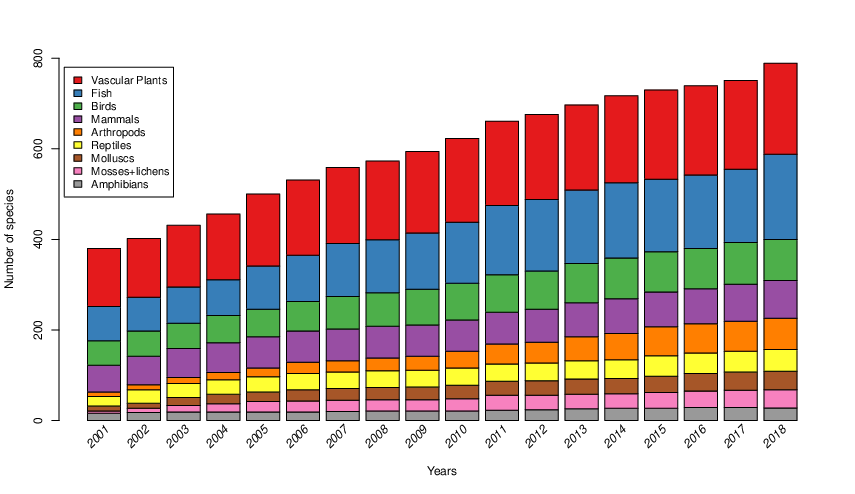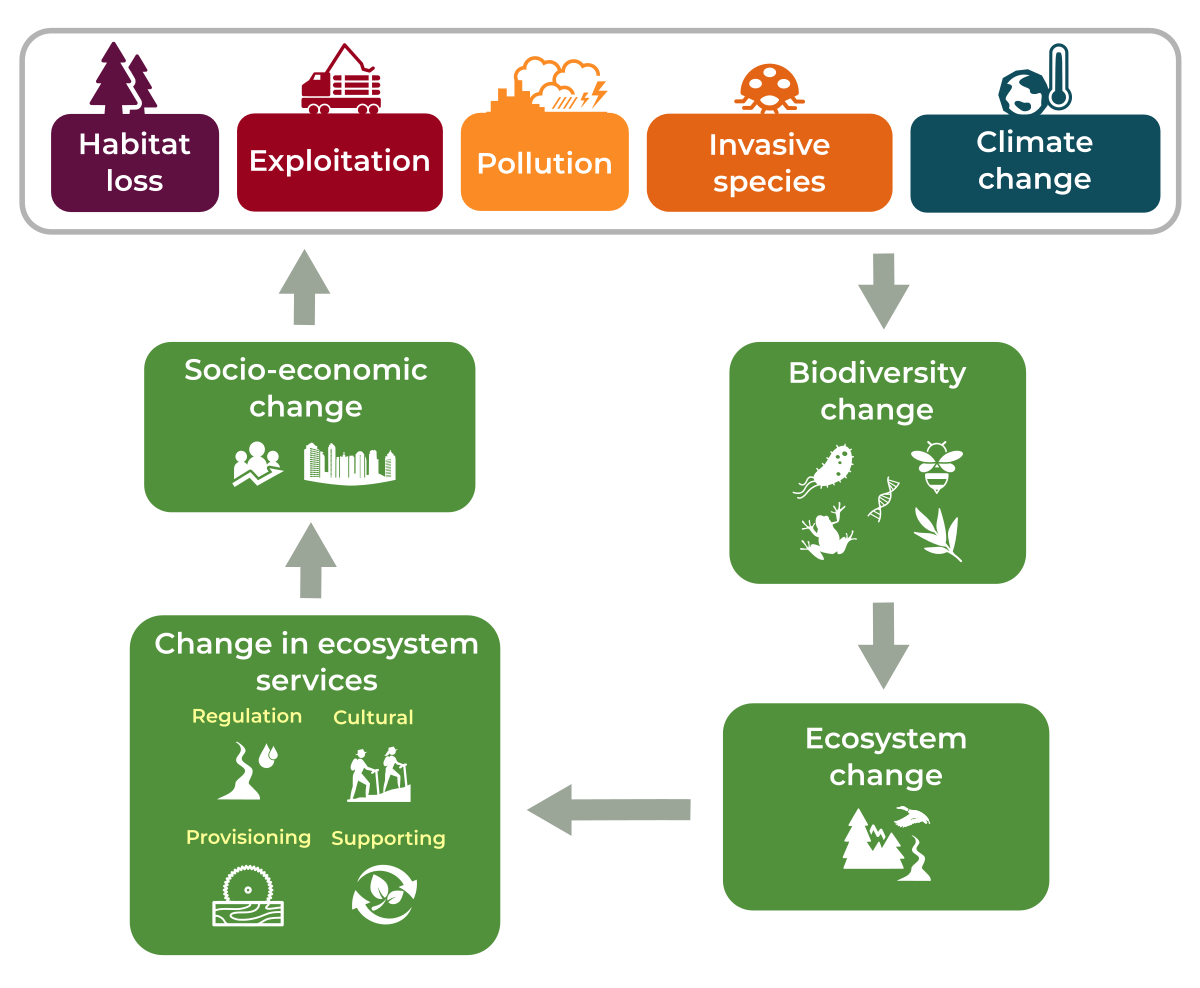Defining biodiversity Science



The biodiversity concept
The topic of biodiversity has been a fascinating center of attention for almost 50 years. Since the early 1980’s, scientists have used the concept of biological diversity (for ex., Lovejoy, 1980) while the short form, biodiversity, has been used since the American National Forum on Biodiversity in 1986 (Wilson, 1988). Biodiversity refers to the great variety of life on earth in all its forms, from genes to ecosystems, from bacteria to whales, including humans, and from oceans to the arctic tundra. Multiple interacting levels of biodiversity can be recognized:
- Genetic diversity represents the inter-individual diversity of genes. This component of biodiversity greatly affects the adaptive potential of species in the face of environmental change. It allows to maintain the viability of populations over time and increases the survival potential of the species.
- Species diversity represents the number of species that live in a given area. Each species possesses, in turn, its own genetic diversity.
- Ecosystem diversity represents the diversity and the ecological interactions of ecosystems. It comprises the species diversity in a given area.
- Functional diversity represents the diversity of elements that influence the functioning of an ecosystem. This diversity includes the species diversity as well as the diversity of each species’ functional traits.
Biodiversity represents a natural heritage essential for human well-being. In the last few decades, the loss of biodiversity has happened at a worrying rate in Canada and throughout the planet due to habitat loss, resource exploitation, land use change, pollution, invasive species or climate change. This biodiversity loss has important consequences for the global economy and for human well-being. The year 1992 marked an important shift in the social and political recognition of biodiversity at the United Nations Conference on Environment and Development in Rio de Janeiro and with the establishment of the Convention on Biological Diversity (CBD) of which the Canada is a signing party. Since then, the use of the term biodiversity has spread from the scientific community to the general public.
BIODIVERSITY LOSS
There is now a general consensus in the scientific community that biological diversity is being lost at a rate that is unprecedented in human history. In 2017, the Red List from the International Union for the Conservation of Nature revealed that 28 % of the more than 92 000 species evaluated where threatened by extinction – an increase from the 22 % cited in 1998 (UICN, 2017). According to conservative estimates, the rate of vertebrate species loss is now 100 times higher than the rate that is considered normal. This leads many to conclude that we are currently undergoing the 6th mass extinction in the earth’s history (Ceballos et al., 2015). For the first time, this mass extinction is directly caused by humans as opposed to natural phenomena (meteorites, climate cycles, etc.). This rate of species loss is expected to reach its peak in the next 50 years.
Among the groups that have been more intensively studied, amphibians seem to be the most in peril, with more than 40 % of its species that are threatened by extinction (Monastersky, 2014). For other groups such as microbes, insects and fungi, knowledge is more limited and only a small fraction of the species have been described and studied. In general, species evaluated by IUCN for extinction risk only represent about 4 % of known species, which in turn only represents a very small proportion of the total estimated number of species on earth: between 2 and 50 millions (Monastersky, 2014). There is therefore a lot of uncertainty and much unknown concerning the extent of biodiversity status and loss.
As is the case at the international level, Canada’s biodiversity is also threatened. The number of species of animals and plants considered extinct or threatened by the Committee on the Status of Endangered Wildlife in Canada (COSEWIC) has increased and the status of several of these species has been worsening. Of the 735 wild species evaluated by the COSEWIC, 321 are endangered, 172 are threatened, 219 are of special concern, 23 are extirpated (meaning we don’t find them in the wild in Canada) and 16 are considered extinct (Mooers et al., 2010).

Number of species considered at extinct or at risk in Canada according to COSEWIC
This figure shows the general increase in the number of species that are extirpated, endangered, threatened, or of special concern.
In parallel with the rapid decline in the number of species, there is also a sharp decrease in the size of many populations. For example, according to a recent IPBES report, populations of species have declined by more than 31% in the Americas since pre-colonial times. According to a business-as-usual scenario, this decrease could reach 40% in 2050. Such important losses are also expected in other continents. In natural reserves in Germany, Hallmann et al. (2017) observed a 75% decrease in the number of flying insects. In France, more than 55% of the birds on farmlands have disappeared since 1980, caused by the decrease in the available insect biomass and generalized pesticide use.
Finally, such high rates of species and population loss can lead to an erosion of genetic diversity that is necessary for the adaptation of species to constant environmental change and habitat destruction. With a number of individuals that is large enough and a diverse genetic pool, species can usually adapt to a gradually changing environment. However, smaller populations often struggle to adapt to environmental changes, especially when they occur rapidly and simultaneously.
There is no general consensus as to the rate of biodiversity loss that the biosphere and human societies can absorb, but data seems to indicate that the critical planetary threshold that defines the safe and tolerable rate of biodiversity loss has already been crossed (Rockström et al., 2009). Numerous studies on the impact of biodiversity loss on ecosystem functions and services (for ex. Naeem et al., 2009) have established that declines in species numbers and genetic diversity can have an impact on ecosystem processes such as biomass production, soil fertility, nutritional uptake, seed dispersal, plant pollination, resistance to invasive species, regional climate regulation, and protection against natural disasters such as floods and large storms (Crutsinger et al., 2006; Cardinale et al., 2007; Diaz et al., 2006, Cardinale et al 2012).
The notion of ecosystem services
The concept of ecosystem services (ES) (Daily et al. 1997; Ma 2005) is particularly useful to illustrate the link between society, the economy and the natural world: it consists of all the benefits that we obtain from the functioning (climate regulation), management (aquaculture, cultural services associated with protected areas), provisioning (fisheries) or destruction (fossil fuels) of ecosystems (Houdet et al. 2012). These benefits are the result of multiple complex interactions between biodiversity, ecological structures, ecological functions, processes, final services and beneficiaries (Boyd et Banzhaf, 2007; Fisher et Turner, 2009 ; Ruhl et Salzman, 2007).
There are multiple ways to classify ecosystem services, including the classification published by the Canadian government (Working Group on The Value of Nature to Canadians, 2017) to support the analysis and decision making of stakeholders. This classification combines the ones proposed by the Millennial Assessment (MA) and The Economics of Ecosystems and Biodiversity (TEEB, http://www.teebweb.org/). The Canadian government classifies ecological services into provisioning (ex. fisheries), regulating (erosion, water flow), cultural (spirituality, cultural identity) and supporting or habitat services (soil formation).
Economic value
Air and water quality, two elements essential to all life forms, depend on renewable cycles and healthy and diverse ecosystems. Forests play a key role in controlling air quality and in a predictable and viable water cycle, while soil organisms are important for soil quality. Plants depend on soil quality; animals depend on plants. Humans thus represent just one of the links in this chain that could break if we over-consume resources and destabilize the equilibrium that maintains life on Earth.
Biodiversity plays an important role in human well-being, a role that is undervalued by the global economy. Yet, ecosystem services represent a global monetary value of multiple billions of dollars (Costanza et al. 1997), a convincing economic argument in favor of conservation and sustainable use of biodiversity (Balmford et al., 2002; Rudd, 2009).
In Canada, biodiversity plays a key role in the economy since an important part of the gross domestic product is directly tied to it (CDB, 2006). For example, services supplied by Boreal ecosystems which cover more than half of Canada’s territory can reach a value of 93 million dollars per year, or 9 % of the GDP (Anielski et Wilson, 2005). Moreover, ecological and socio-economic advantages of current boreal systems could be much higher than the market value of resources they supply (forestry, oil, natural gas, etc.).
The collapse of the cod industry in Newfoundland and Labrador is another example of the economic importance of biodiversity in Canada. The decline of cod populations lead to a loss of more than 35 000 jobs, as well as a decrease of 200 million dollars per year in harvested cod (MacGarvin, 2001). Similarly, exotic invasive species often establish and grow very quickly in natural environments where they don’t have natural enemies. They displace native organisms, disturb local biodiversity, affect the habitat quality and can even destroy entire ecosystems (zebra mussels, Asian carps, Emerald ash borers) and can cause diseases. In Canada, these species can cause billions of dollars in economic losses each year (for ex., Colautti et al., 2006).
Finally, biodiversity is also an important source of inspiration and innovation for the pharmaceutical and biotechnological industries. More than a third of new medications are derived from compounds extracted by natural products. Conservation of biodiversity is thus essential for future discoveries.
Cultural value
Human cultures past and present have been greatly influenced by biodiversity, leading to the great cultural diversity observed throughout the world. Spiritual values, beliefs and even cultural practices such as songs, storytelling and legends reveal the tight relationship between humanity and the environment. Biodiversity also possesses aesthetic value: beautiful landscapes that are intact provide great visual pleasure and potential for recreation. These aesthetic values can also become economic by generating additional revenues for botanical gardens, national parks, and wildlife conservation areas, for example.
Biological and cultural diversity are forming an even tighter link for indigenous populations whose traditional knowledge and subsistence living depend directly on nature and biodiversity. In Canada, edible plants with cultural value, such as marine algae (Porphyra abbottiae) and Pacific crabapple trees (Malus fusca) were traditionally consumed in great quantity by First Nations of the West Coast (Turner et Turner, 2008). Today, these two species are designated as “culturally at risk”.

Biodiversity science
Traditional scientific approaches are no longer sufficient to address and solve the biodiversity crisis. Since biodiversity changes are greatly influenced by human activity, we have to combine research in natural and social sciences. Biodiversity science is thus an multi-disciplinary field using tools and theories from different areas such as molecular biology, taxonomy, genetics, traditional ecological knowledge, political sciences, ecoinformatics, economy and ecology. Biodiversity science offers a research framework that integrates different political and scientific fields allowing to better tackle the continuously evolving threats to biodiversity. A better understanding of the cause and maintenance of biodiversity will allow a better prediction of its response to human activities. Underestimating biodiversity amounts to underestimating the value, the functions and the services obtained by the use of biodiversity and can compromise human-well being (Seddon et al.,2016).
Nevertheless, the scientific community has still not succeeded in convincing the general public that we are at the dawn of a biodiversity crisis (Cardinale et al., 2012), unlike climate scientists concerning climate change. It was shown that media coverage related to biodiversity was eight times less present than that for climate change, despite the fact that a similar number of scientific studies are undergone for both fields of research (Legagneux et al., 2018). Media coverage related to climate change was often linked to specific events (hurricanes, floods, etc.), which is not the case for biodiversity since biodiversity loss seems harder to convey. Biodiversity science requires a continuous development and adaptation both on the research front and on the communication of issues and the importance of taking action.
